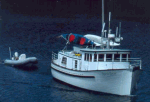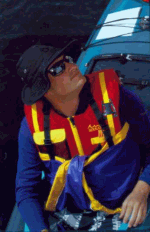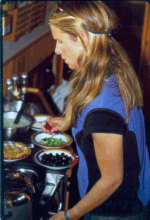written and photographed by Mary L. Peachin
May 2001, Vol. 5 No. 7
 We looked like a colorful rainbow as we paddled red-and-turquoise two-person kayaks past banks of island forests. Under our red spray skirts, which kept us dry, we wore yellow PFDs (personal floatation devices) covered by green, yellow, or red rain jackets. The area— the Inland Passage between Vancouver Island and Alaska, specifically the Straits of Johnstone—is colorful, but we stood out in our clearly manmade finery, which alerted passing boats and cruise ships to our presence.
We looked like a colorful rainbow as we paddled red-and-turquoise two-person kayaks past banks of island forests. Under our red spray skirts, which kept us dry, we wore yellow PFDs (personal floatation devices) covered by green, yellow, or red rain jackets. The area— the Inland Passage between Vancouver Island and Alaska, specifically the Straits of Johnstone—is colorful, but we stood out in our clearly manmade finery, which alerted passing boats and cruise ships to our presence.
 In the straits, cedar, hemlock, and shore pine were edged by berry-laded salal shrub (a delicacy for the local bears). The crystalline waters flowing past bull kelp and eel grass revealed bright red blood- and sea stars, anemones, sea cucumbers, and an occasional river otter or harbor seal. Schools of juvenile pink salmon and herring darted past our paddles. Bald eagles perched on tall firs, sighting for fish, while great blue herons and black oystercatchers waded on rocky shores. On the shore, deer peeked from the trees and a mother raccoon eyed us warily, protecting her fuzzy cubs from the intruders.
In the straits, cedar, hemlock, and shore pine were edged by berry-laded salal shrub (a delicacy for the local bears). The crystalline waters flowing past bull kelp and eel grass revealed bright red blood- and sea stars, anemones, sea cucumbers, and an occasional river otter or harbor seal. Schools of juvenile pink salmon and herring darted past our paddles. Bald eagles perched on tall firs, sighting for fish, while great blue herons and black oystercatchers waded on rocky shores. On the shore, deer peeked from the trees and a mother raccoon eyed us warily, protecting her fuzzy cubs from the intruders.
 My family—my husband, David, daughter Suzie, son Jeffrey and his girlfriend, Kristin—had chartered a floatplane to fly us into Farewell Harbour, two hours south of Port McNeill, British Columbia. There we met the kayak-laden 40-foot Spirit Bear, operated by Northern Lights Expeditions, for three days of cruising and kayaking.
My family—my husband, David, daughter Suzie, son Jeffrey and his girlfriend, Kristin—had chartered a floatplane to fly us into Farewell Harbour, two hours south of Port McNeill, British Columbia. There we met the kayak-laden 40-foot Spirit Bear, operated by Northern Lights Expeditions, for three days of cruising and kayaking.
The Spirit Bear, a former fish trawler, was totally renovated, with a loving touch, by Northern Lights owner David Arcese. The boat is designed for a maximum of four guests, but our family of five scrunched in: David and I slept (lying like pencils) on the kitchen table, which converted into a bed, with the kids distributed between the bed in the wheelhouse and a master stateroom with a shower. Alvin had a cabin and head (which we could use) in the fo’csle, and there was a pumping head next to the dining table/bed. The top deck could be used for sleeping, although it was too cold during our trip. Despite the close quarters, we were cozy and happy to be family.
 On the boat, Northern Lights guide Jenny MacPhee led us through safety instructions for the boat and the fiberglass kayaks. We then got underway, skipper Alvin Sewid, a member of the local Mamaliligula tribe, heading the boat south to Cracraft Island.
On the boat, Northern Lights guide Jenny MacPhee led us through safety instructions for the boat and the fiberglass kayaks. We then got underway, skipper Alvin Sewid, a member of the local Mamaliligula tribe, heading the boat south to Cracraft Island.
The following three days unfolded in much the same way: Each day we paddled for several hours, exploring the straits and coming in close contact with local marine life. Jenny, at mealtime acting as chef, worked in the small galley, and sometimes it seemed as if we paddled from meal to delicious meal—one night, we feasted on pizza, choosing from a menu of toppings that included artichoke hearts, olives, avocados, grilled or raw onion, yellow, green, or red peppers, garlic, pesto, and marinara sauce. Pastas were equally varied, as were fresh salads topped with tomatoes, olives, blue cheese, and walnuts. Desserts varied, ranging from cakes made with fresh fruit and granola to rich chocolate brownies. Breakfast was fresh fruit and Tasmanian toast (cream cheese between two pieces of grilled buttered toast).
 But food was far from the only draw. We had also come to these waters for some whale watching, hoping to see orca (more commonly known as killer whales). But the more traveled straits are subject to a “whale jam,” boat gridlock wherever orca are sighted. We decided to forego kayaking in the heavy boat traffic of the Straits, opting instead for wilderness paddling. We were lucky to sight whales several times, each time climbing back into Spirit Bear and cruising closer for a good look. Away from the crunch of traffic, they swam around and under the boat, giving us clear and beautiful views.
But food was far from the only draw. We had also come to these waters for some whale watching, hoping to see orca (more commonly known as killer whales). But the more traveled straits are subject to a “whale jam,” boat gridlock wherever orca are sighted. We decided to forego kayaking in the heavy boat traffic of the Straits, opting instead for wilderness paddling. We were lucky to sight whales several times, each time climbing back into Spirit Bear and cruising closer for a good look. Away from the crunch of traffic, they swam around and under the boat, giving us clear and beautiful views.
 Our kayaking route took us to anchorages at Klaoitisis Island, Mound Island, and Codfish Pass in the Pearce Islands. One afternoon, Suzie and I fished for dinner while David, Jeffrey, and Kristin tried a “rope-and-ladder” technical climb on Little Kai Island. Each night we lowered a prawn trap, but succeeded in catching only one prawn, which we released.
Our kayaking route took us to anchorages at Klaoitisis Island, Mound Island, and Codfish Pass in the Pearce Islands. One afternoon, Suzie and I fished for dinner while David, Jeffrey, and Kristin tried a “rope-and-ladder” technical climb on Little Kai Island. Each night we lowered a prawn trap, but succeeded in catching only one prawn, which we released.
 The culture of the region was also much in evidence, and here Alvin, with his Native heritage and a lifetime of experience in local waters, added greatly to our experience of the trip. Early on, we stopped to admire some pictographs and a “chief’s bath,” both carved into the granite rocks of Crease Island. Another day we visited the 10,000-year-old abandoned village of Mimkwinlis. Alvin’s son, Tom, has assumed the role of guardian of the village’s 14 fluted-beam dwellings, once inhabited by the Kwakiutl people. We sat at the beachfront for an hour as Tom told us the legends of his ancestors, finishing up with more recent tales featuring the exploits of his late grandfather, a Kwakiutl chief.
The culture of the region was also much in evidence, and here Alvin, with his Native heritage and a lifetime of experience in local waters, added greatly to our experience of the trip. Early on, we stopped to admire some pictographs and a “chief’s bath,” both carved into the granite rocks of Crease Island. Another day we visited the 10,000-year-old abandoned village of Mimkwinlis. Alvin’s son, Tom, has assumed the role of guardian of the village’s 14 fluted-beam dwellings, once inhabited by the Kwakiutl people. We sat at the beachfront for an hour as Tom told us the legends of his ancestors, finishing up with more recent tales featuring the exploits of his late grandfather, a Kwakiutl chief.
The day following our visit, Alvin received a radio call from Tom, who’d heard of our prawn-trapping failures. He was bringing us “gomies,” fresh Dungeness crab, which we ate that night as an appetizer to the rock cod we’d caught earlier that afternoon.
 Most Northern Lights trips are seven days, but the kids’ work schedules kept ours to three. On the fourth day, we reluctantly left the Spirit Bear and headed north to Point McNeill, where the kids would head back to work and David and I would take a floatplane over to the luxurious Wickinnish Inn on the west coast of Vancouver Island in Tofino. After a wonderful family adventure and great kayaking, we could hardly wait for a roomy bed and a long, hot shower.
Most Northern Lights trips are seven days, but the kids’ work schedules kept ours to three. On the fourth day, we reluctantly left the Spirit Bear and headed north to Point McNeill, where the kids would head back to work and David and I would take a floatplane over to the luxurious Wickinnish Inn on the west coast of Vancouver Island in Tofino. After a wonderful family adventure and great kayaking, we could hardly wait for a roomy bed and a long, hot shower.
If you go: Northern Lights 800-754-7402 info@seakayaking.com www.seakayaking.com
